Acquisition Setup (Eye Mode)
This topic describes the Acquisition Setup dialog's Waveform tab when FlexDCA is in Eye Mode. Use the Acquisition Setup dialog's Waveform tab to define the way you want the instrument to acquire data from the input waveform.
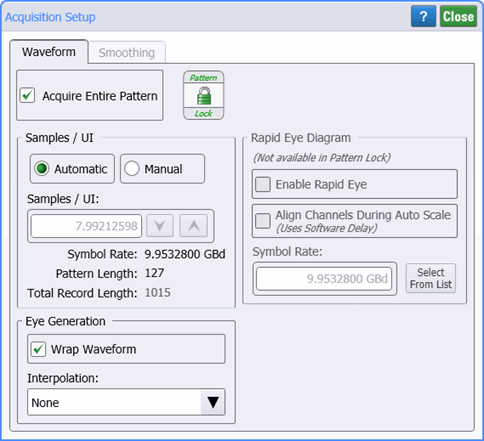
Acquire Entire Pattern
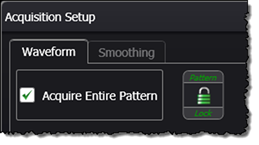 Select Acquire Entire Pattern to capture the entire pattern waveform. Pattern Lock must be turned on before the Acquire Entire Pattern selection becomes available. On each waveform acquisition, data from the entire pattern is acquired. (Normally, only data from the displayed portion of the pattern is acquired.) The Minimum Timebase Position control establishes the start of the pattern and the Symbol Rate and Pattern Length determine the time duration.
Select Acquire Entire Pattern to capture the entire pattern waveform. Pattern Lock must be turned on before the Acquire Entire Pattern selection becomes available. On each waveform acquisition, data from the entire pattern is acquired. (Normally, only data from the displayed portion of the pattern is acquired.) The Minimum Timebase Position control establishes the start of the pattern and the Symbol Rate and Pattern Length determine the time duration.
Long patterns may require some noticeable time to be acquired. When acquiring the entire pattern, the Pattern Navigation Display shown here is displayed at the top of the display.

Specify Record Length As
If the Acquire Entire Pattern settings is turned off, you can use the Specify Record Length As setting to select a waveform record length based on Samples/Waveform or Samples/UI. Samples/Waveform is the number of waveform samples acquired across a single sweep. This setting affects the Sweep time (display update rate), Histograms, and Measurements.
To use this setting, Acquire Entire Pattern must be turned off. Otherwise, the waveform record length is forced to be Samples / UI.
Automatic / Manual
You can select Automatic or Manual for the record length. Automatic, the default setting, sets the record length to optimize the single record length versus total database update rate. Automatic is the recommended setting when using:
- Color grade or gray scale waveforms
- Histograms
- Eye mask tests
Manual allows you to define a record length between 16 to 10,485,760 Samples/Waveform (or 1 to 4096 Samples/UI). The default value is 2048 Samples/Waveform or 4096 Samples/UI. Increasing the number:
- Reduces the time spacing between the measurement points. The time spacing between measurement points can affect interpolation between the points used to make measurements.
- Increases the time required to capture a single sweep.
AutomaticThe optimum record length is based on the width of the display graticule (2048 points). Therefore, in Automatic, a multiple of the graticule width is selected as the record length. This results in an even distribution of data points sampled from the input waveform. For example, Automatic may select 4096 points (two times 2048) as the record length. Manually setting the record length to a value other than a multiple of 2048 results in an uneven histogram of the waveform.
Eye Generation
By default Wrap Waveform is on so that an eye diagram is viewed. With Pattern Lock on and Acquire Entire Pattern selected, Wrap Waveform is displayed in the dialog to give you the option to turn wrapping off. Since the displayed eye diagram is built from a pattern lock, you can apply waveform averaging via the Smoothing controls. When Wrap Waveform is not selected, a single-valued pattern waveform is displayed. In Eye/Mask mode you can save the pattern in an ASCII file (*.csv) or internal format file (*wfmx). Click File > Save > Waveform and select either Pattern Waveform or Waveform Files (internal).
Wrap Waveform OFF
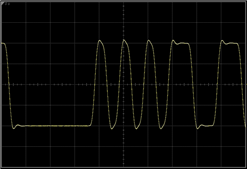
Wrap Waveform ON
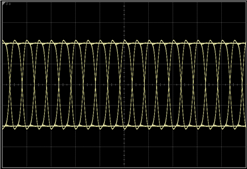
With pattern lock on and Acquire Entire Pattern selected, the Sample/UI entry is shown on the dialog and is a real number instead of an integer. FlexDCA uses a real number so that, if wrapped, the entire eye diagram is filled in without needing to interpolate between sample points. With an integer entry, the samples for each symbol in the pattern would occur at the same time offset as measured from the start of each symbol. The samples for each symbol would be aligned and would be drawn on the display at the same horizontal offset (although their amplitude may vary). As a result, the eye diagram would take much longer to be filled. An integer number can be manually entered, if needed.
Rapid Eye Diagram
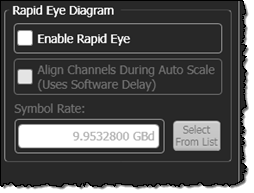
On the right side of the dialog, you'll find settings for the Rapid Eye Diagram feature, which significantly reduces the time required to acquire waveform samples on channels and differential waveforms. It employs several techniques that improve measurement efficiency. To turn on Rapid Eye, first disable pattern lock if it is on. Rapid Eye does not work with pattern lock. Select Enable Rapid Eye to turn on Rapid Eye and then enter the Symbol Rate.
If multiple eye diagrams are displayed, select Align Channels During Auto Scale to enable an Auto Scale to align the eyes. The eye diagrams are aligned using software delay.
Use Rapid Eye with channels or differential waveforms only. Rapid Eye is not compatible with functions.
Rapid Eye is not available when pattern locking is on. When pattern lock is on, the Acquire Entire Pattern the feature is available in this dialog which provides as fast as measurement throughput times as Rapid Eye. As a result, if pattern lock is off, use Rapid Eye. If pattern lock is on, use Acquire Entire Pattern.